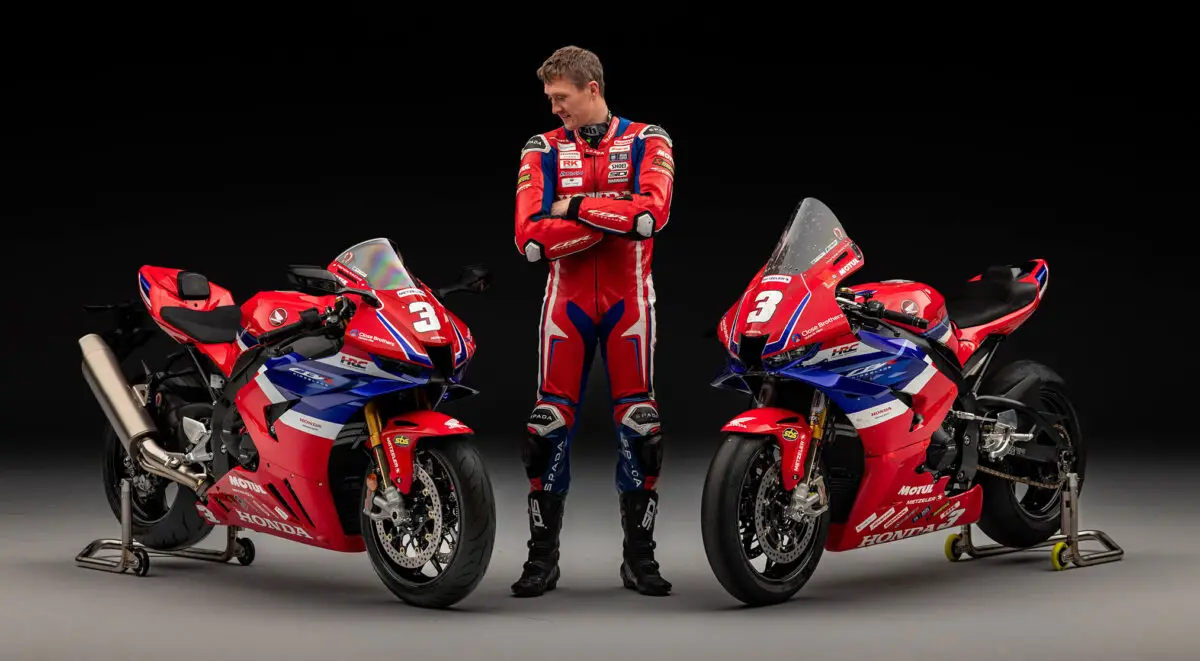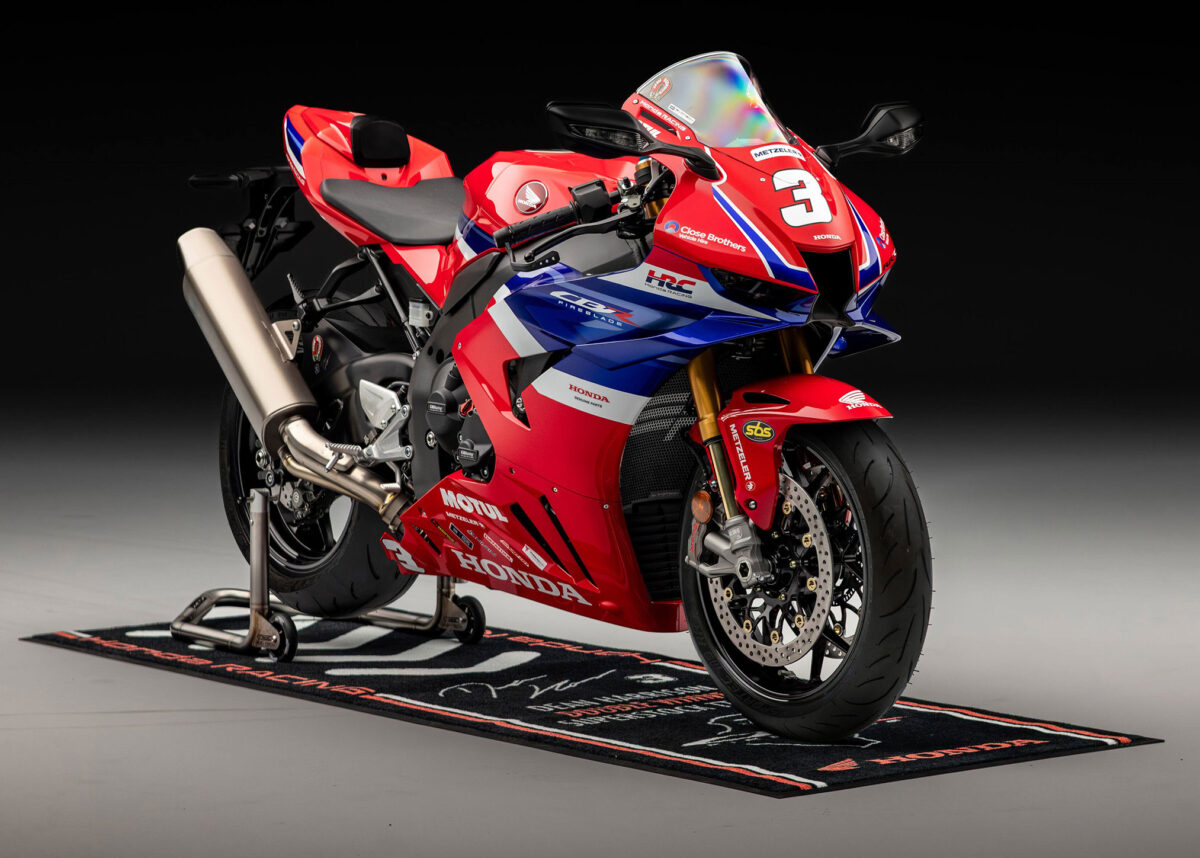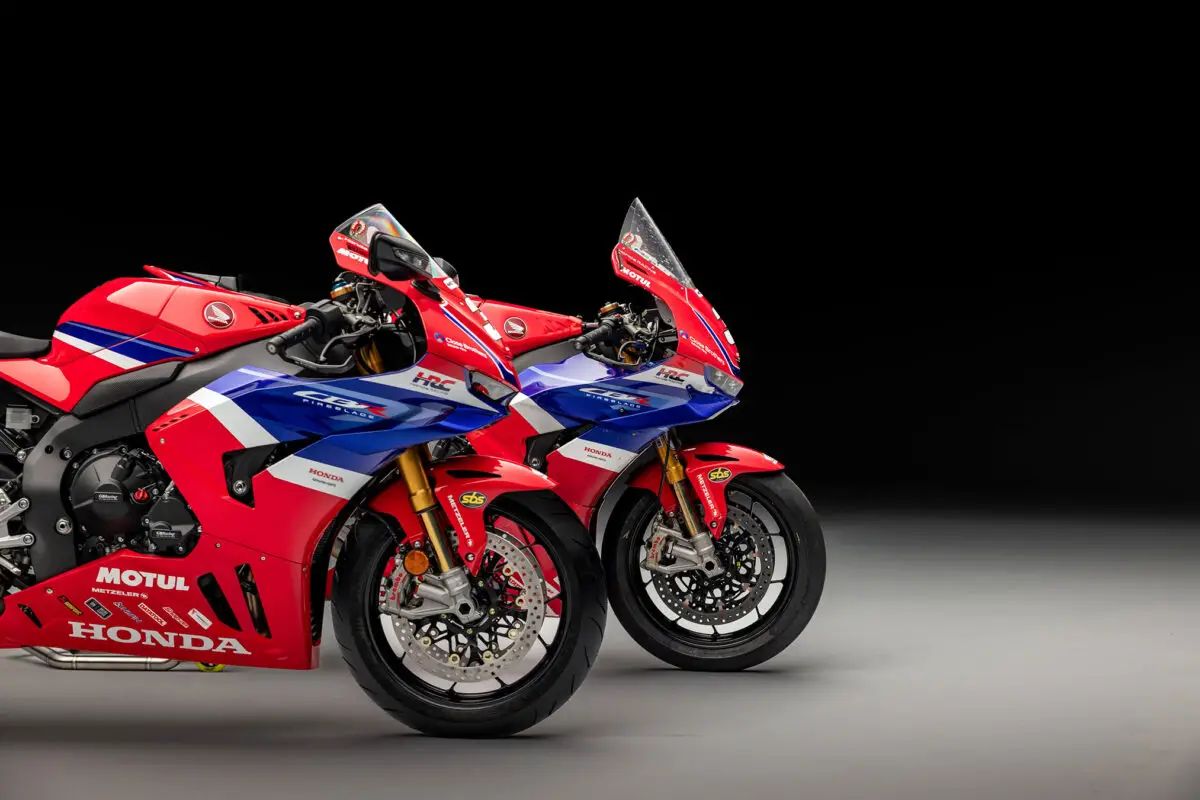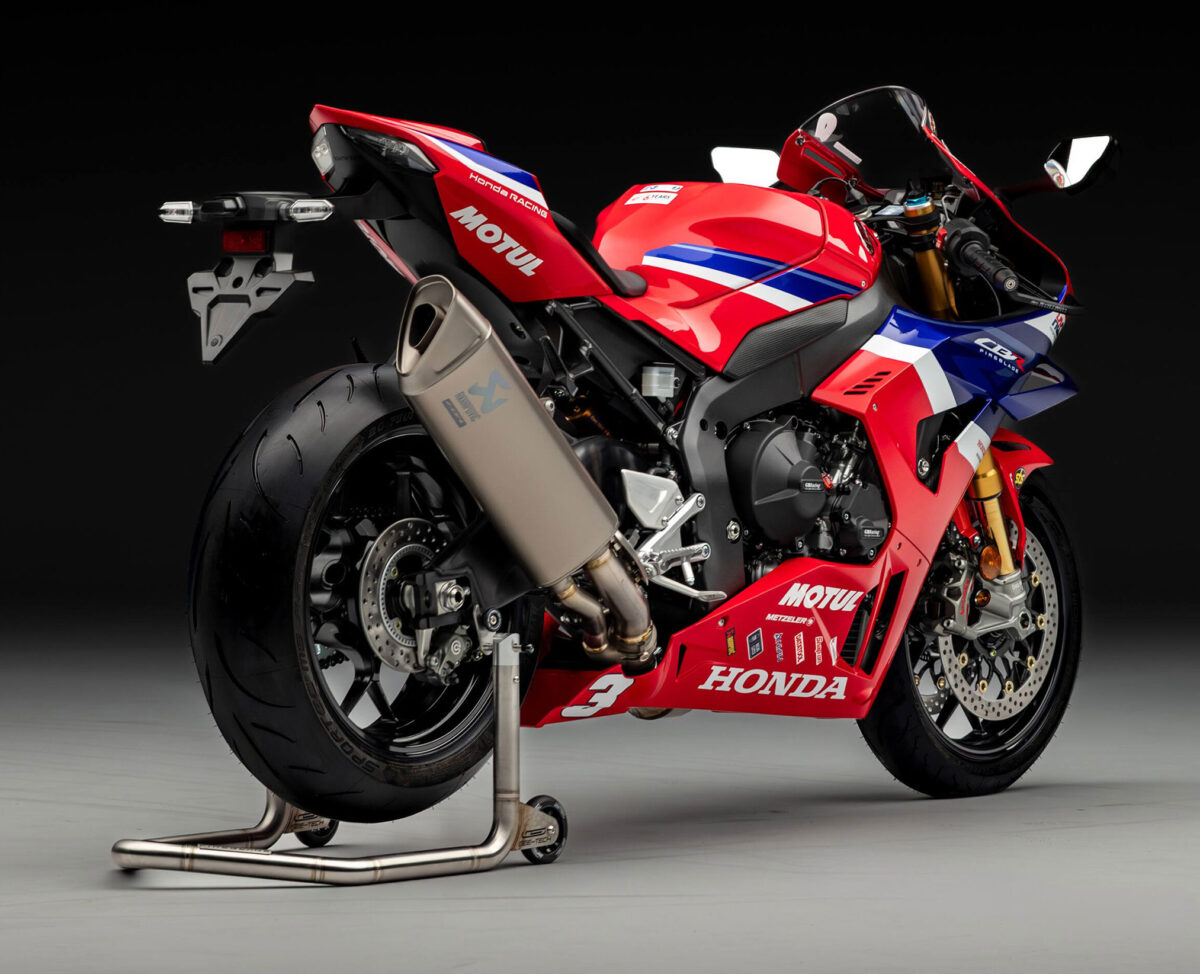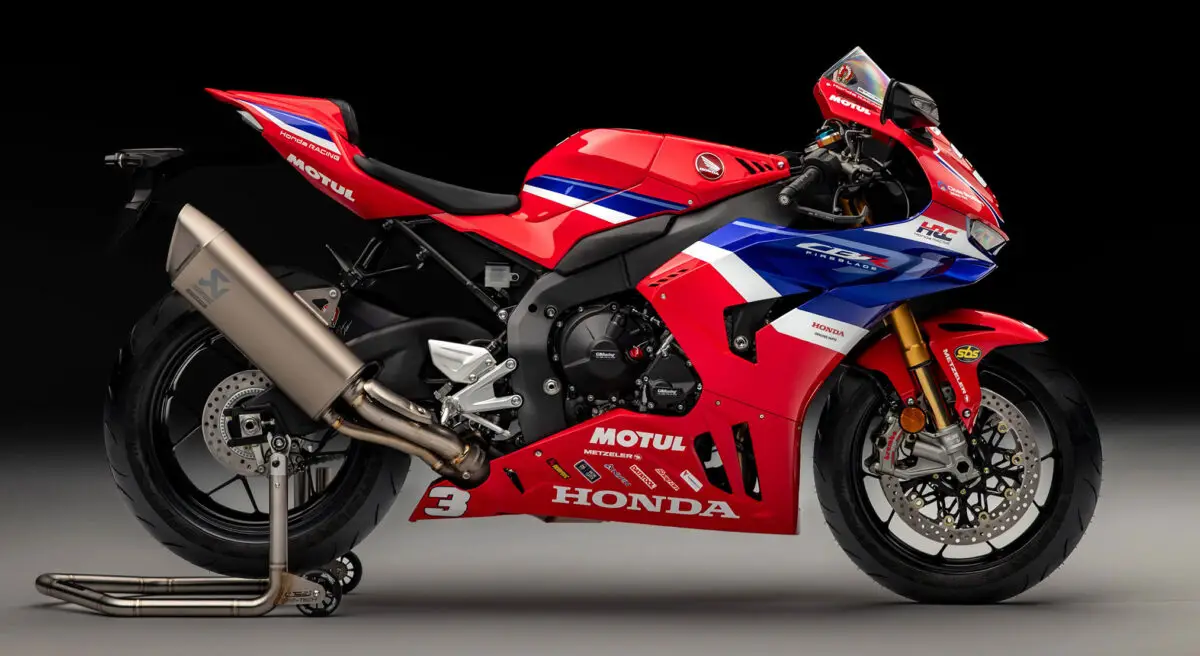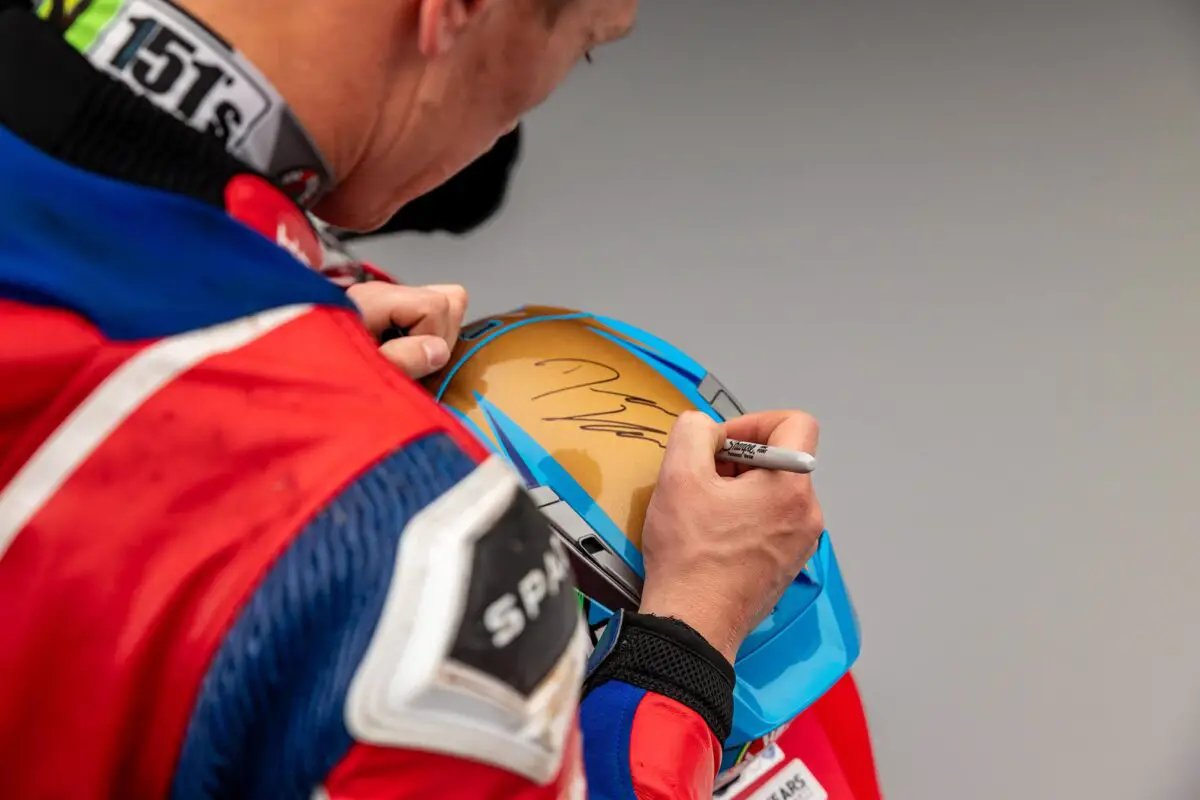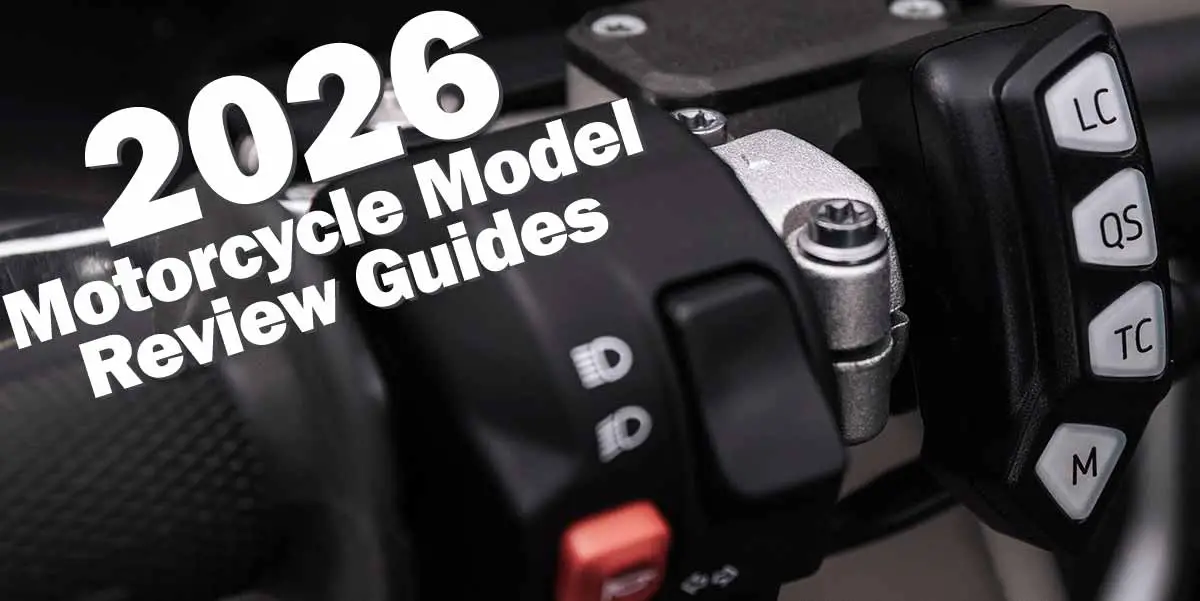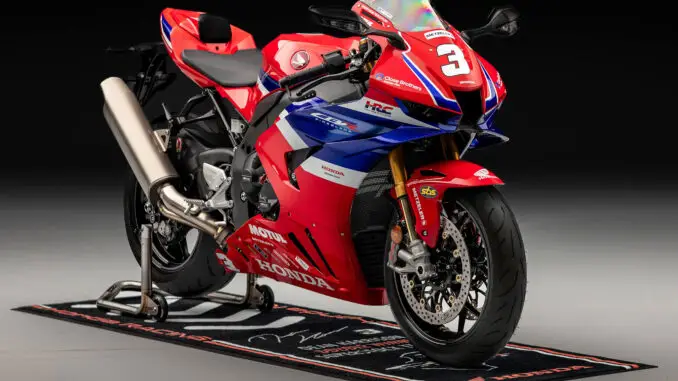
Honda UK are set to reproduce, as near as possible, the Honda CBR1000RR-R Fireblade SP Dean Harrison Replica. An exact replica of the bike Dean Harrison rode so brilliantly for just 12 lucky customers.
Review – Key Features – Features & Benefits – Specifications
2026 Honda CBR1000RR-R Fireblade SP Dean Harrison Replica: LUCKY 12.
Introducing the 2026 Honda CBR1000RR-R Fireblade SP Dean Harrison Replica…
The CBR1000RR-R Fireblade SP has proved itself as the 2025 Superstock weapon of choice for BSB short circuits and, at this year’s TT, as the ultimate Superstock machine on the real roads of the Isle of Man racing to two victories in the hands of Honda Racing’s Dean Harrison.
And to celebrate both wins – plus the stunning 135.692mph average speed on the final lap of Race 1 (the third fastest lap in TT history) – Honda UK are set to reproduce, as near as possible, an exact replica of the bike Harrison rode so brilliantly for just 12 lucky customers.
He’s suitably stoked about the project:
“This year’s TT was so special for me. We dialled my Fireblade in all the way through and it just got better, and better. My fourth TT win felt it was a long time coming, while the fifth left me lost for words. I’m so proud to be part of such an amazing team and, if I’m honest, really proud that Honda UK are producing a replica of the bike we put together and on the top step of the podium, twice. If it looks right, it is right they say in racing and each of these bikes does just that, with every detail spot-on. And I know they’ll be mind-blowing wherever they’re ridden – road or track.”
2026 Honda CBR1000RR-R Fireblade SP Dean Harrison Replica Totalmotorcycle.com Key Features
- Detailed reproduction of the bike Dean rode to two Superstock victories at this year’s Isle of Man TT
- Only 12 to be produced, with full Race Replica livery plus a host of parts and accessories
- Retail price of £26,749; orders can be placed only through the Honda dealer network
2026 Honda CBR1000RR-R Fireblade SP Dean Harrison Replica Totalmotorcycle.com Features and Benefits
The 2025 CBR1000RR-R Fireblade SP is a bike built to win out of the box – or amaze on the open road. Loaded with MotoGP aero, electronics and chassis tech its four-cylinder engine, with 2-motor Throttle by Wire control, delivers major mid-range drive plus huge top-end power. Öhlins Smart Electronic Control (S-EC03) suspension and Brembo Stylema R four-piston front brake calipers are top-draw, as is Cornering ABS with RACE setting. All in all, the CBR1000RR-R Fireblade SP starts out as one incredible motorcycle.
But to take it to next level, each Dean Harrison Replica CBR1000RR-R Fireblade SP gets:
- Full Race Replica Livery
- Individually numbered headstock plaque
- Honda Genuine Accessories – Tall Screen, Rear Seat Cowl and HRC Oil Filler Cap
- GB Racing Engine Cover Set
- Evotech Radiator Guard, Brake Lever Guard and Paddock Stand Bobbins
- Fitted with Metzeler Tyres with OE Tyres provided as spare
- Only 12 to be built with a retail price of £26,749
There’s more. Alongside the bike itself, the package also includes:
- Shoei X-SPR Pro Dean Harrison Limited Edition Helmet – signed by Dean in the customer’s preferred size
- Gee-Tech rear Paddock Stand with CBR Fireblade logo
- Custom Garage Mat
All enquiries for the Dean Harrison Replica CBR1000RR-R Fireblade SP are to be made via the Honda dealer network.
ABOUT THE MAN
Dean Harrison, originally from Bradford and now Manx-domiciled, was born in 1989 and has raced since he was 18 years old. He’s known as a roads specialist – it’s in the blood, his father Conrad Harrison won a sidecar TT in 2014 – with 5 TT wins to his name, and has garnered success at the North West 200, Ulster GP and Oliver’s Mount. But 2025 has also seen his stock rise sharply on Britain’s short circuits, in the Supersport class aboard Honda Racing’s CBR600RR. It’s never a straightforward transition between real roads racing and BSB, but Harrison makes it look easy. And that’s down to talent.
Neil Fletcher, Head of Racing and Development, commented:
“It’s a genuine privilege to be involved in this project, which marks a fitting tribute to Dean’s outstanding performance at this year’s Isle of Man TT. We received an incredible response to a similar initiative celebrating John McGuinness’s 100th TT start, and I’m confident that the 12 fortunate customers who secure one of these exclusive Dean Harrison replica Superstock Fireblades will be absolutely thrilled with their purchase.”
Based on the 2025 Honda CBR1000RR-R Fireblade SP:
PERFORMANCE
RC213V-SPEC BORE AND STROKE
The Fireblade SP’s bore and stroke (81mm x 48.5mm) are the same as Honda’s MotoGP Champion RC213V racebike, drawing on our experience with cylinder filling and combustion gathered on the track.
FINGER-FOLLOWER ROCKER ARMS
The CBR1000RR-R Fireblade SP uses finger-follower rocker arms. The design reduces the inertia weight of the valve system by approximately seventy-five percent compared to a shim-and-bucket system, and contributes to the Fireblade SP’s higher redline. DLC (diamond-like carbon) coating reduces friction resistance on surfaces sliding against the cam and tappet shim.
INTAKE-PORT SHAPE
The CBR1000RR-R Fireblade SP features intake ports with a special shape to help speed charge velocity. The change gives the engine even better midrange performance, a real benefit when exiting corners.
REFINED AIRBOX SHAPE
Along with the intake-port shape, refinements to the Fireblade SP’s airbox increase the engine’s midrange power.
SEMI-CAM GEAR TRAIN
The CBR1000RR-R Fireblade SP’s cam drive uses a shorter chain than previous designs. A gear on the crank drives an intermediary gear/sprocket, which in turn drives the cam chain, thus shortening the overall chain run.
FORGED ALUMINUM PISTONS
You need a light piston to make high revs. To that end, the CBR1000RR-R Fireblade SP features pistons forged out of A2618 aluminum, the same material used in the RC213V. Each piston is now lighter by approximately five percent compared to a CBR1000RR piston, even though the bore is bigger.
BUILT-IN BOTTOM BYPASS COOLING
Our unique built-in bottom bypass cooling system sends cooling water differently around the top and the bottom of the cylinder. The top needs more cooling, while the bottom needs less. The technology eliminates the existing hose outside the cylinder block. Cooling water coming out from the radiator flows into areas needing to be cooled more. As a result, the difference in temperature at different locations on cylinder bores becomes smaller, so that bores are less distorted, reducing friction.
DIRECT STARTER LAYOUT
Normally a motorcycle engine is started up by rotating the crankshaft; however, for the CBR1000RR-R Fireblade SP, the starter acts on the clutch main shaft. In addition to shortening the crankshaft, double use of the primary driven gear to transmit rotation from the starter motor makes an even more compact layout possible.
NARROWER INTAKE-SIDE VALVE ANGLE
The intake valve angle is a super-narrow nine degrees (two degrees narrower than on the CBR1000RR). This improves ventilation efficiency inside the intake port by approximately two percent, contributing to higher power output.
LARGER THROTTLE BODY
The CBR1000RR-R Fireblade SP throttle bore diameter measures a huge 52mm. The oval cross-section inside the throttle body streamlines airflow all the way from the throttle butterfly to the twin intake valves in the head to reduce intake air pressure drop.
FINAL-DRIVE GEARING
To better match the engine’s power and give it more midrange punch, we fine-tuned the final-drive gearing. You’ll feel it every time you crack the throttle!
TECHNOLOGY
FULL-COLOR TFT METER
The CBR1000RR-R Fireblade SP is equipped with a larger instrument screen and higher resolution than previous CBR models. You can choose from a menu of screen setting options that display the information you want in a format you prefer, with items like engine temperature, riding modes, speedometer and tachometer, shifter setting, ABS level, gear position, remaining fuel, and much more.
TITANIUM CONNECTING RODS
The CBR1000RR-R Fireblade SP uses titanium con rods, and the rod bolts thread directly into the rod body so there’s no separate fastening nut. The design reduces weight by approximately fifty percent compared to a steel rod, and is the same design as the RC213V-S rod.
THROTTLE-BY-WIRE SYSTEM (TBW)
The CBR1000RR-R Fireblade SP’s throttle-by-wire system smooths and improves throttle response, especially at the critical initial throttle opening. Plus, adopting TBW makes it possible to integrate the CBR1000RR-R Fireblade SP’s riding mode system.
Honda SELECTABLE TORQUE CONTROL (HSTC)
With Honda Selectable Torque Control (HSTC), we have your back, but you’re in control. Here’s how it works: The system automatically adjusts engine power to optimize torque at the rear wheel, reducing rear-wheel slip. You get your choice of five power curves, ten torque-control levels, three engine-braking levels, and now three selectable levels of wheelie control so it’s easier than ever to dial your bike in at the track.
QUICK SHIFTER
The CBR1000RR-R Fireblade SP’s quick shifter is a standard feature. It’s the perfect choice for the trackday rider, and makes shifting faster than ever.
SMART KEY
Eliminating the traditional keyed ignition not only adds convenience, but also lets us streamline the intake ducting for better airflow. Plus, the top tripleclamp has that true racebike look.
HANDLING
ÖHLINS SECOND-GENERATION SMART EC SUSPENSION
The CBR1000RR-R Fireblade SP uses an electronically controlled NPX fork manufactured by Öhlins. By adding a pressurized damping system to the Öhlins fork used by the previous CBR1000RR SP, cavitation inside the damper is minimized to stabilize damping force more and improve bump absorption.
TWIN-SPAR FRAME
The CBR1000RR-R Fireblade SP uses a light-weight aluminum frame with two-millimeter-thick wall sections. This fine tunes both vertical and torsional rigidity for better feel and performance.
LONGER SWINGARM
The CBR1000RR-R Fireblade SP has a special longer swingarm for improved traction on the track. Also, compared to previous designs, horizontal swingarm rigidity was reduced by fifteen percent, while the vertical rigidity remains the same.
BREMBO BRAKES
The CBR1000RR-R Fireblade SP’s front brake discs are a huge 330mm in diameter to improve braking force. The bike features Brembo Stylema front calipers while the rear caliper is the same as the Brembo used for RC213V-S. Even the brake master cylinders and front-brake lever are supplied by Brembo to offer the rider Brembo’s comprehensive braking performance.
AERODYNAMIC WINGLETS
The CBR1000RR-R Fireblade SP is equipped with winglets which effectively generate downforce at track speeds. Three wings are installed in each of the right and left ducts in order to address downforces.
DESIGN
TITANIUM MUFFLER
The CBR1000RR-R Fireblade SP’s muffler was developed jointly with Akrapovič. It’s made out of titanium for light weight, and the design also contributes to the bike’s mass centralization. A special valve in the exhaust helps boost torque at lower revs and increase horsepower at higher rpm.
COMPACT OVERALL CHASSIS
The CBR1000RR-R Fireblade SP wheelbase is just 57 inches for super-responsive handling, while the swingarm measures 24.5 inches in length. The crankshaft centerline is 33mm farther from the front axle and 16mm higher for better front/rear balance with a rider onboard. The rake angle is 24 degrees, with 101.2mm of trail.
SHORTER ENGINE
The CBR1000RR-R Fireblade SP engine is shorter front to back than previous designs, making the bike more compact and allowing our designers more latitude in engine placement in the chassis.
ENGINE / DRIVETRAIN
The Fireblade’s 1,000cc, inline DOHC four-cylinder semi-cam gear engine was designed with heavy input from the HRC MotoGP development program. A huge amount of HRC development has gone into the engine, to change the way it delivers power and torque throughout the rev range, with a goal of increasing drive force to the rear wheel in every gear.
While continuing to share the same oversquare 81mm bore and 48.5mm stroke as the RC213V, valve timing (duration and lift) have been revised for 2025, and compression ratio raised from 13.4:1 to 13.6:1. The inlet valves are 32.5mm diameter (and also lighter for 2025), with 28.5mm exhaust; they’re operated by finger-follower rocker arms; valve angle on the intake side is 9°, reducing the surface area of the combustion chamber and improving combustion efficiency. Also new are three-stage elliptical progressive springs for both inlet and exhaust, while the intake ports have been optimized for gas flow.
MotoGP technology is everywhere internally. Friction is reduced via Diamond Like Carbon (DLC) on the cam lobes, just like the RC213V-S. The 2021 Fireblade was a pioneer for use of this process on a mass-produced motorcycle; it achieves a reduction in valvetrain frictional loss of 35% compared to non DLC-coated lobes.
Connecting rods and connecting-rod caps forged from TI-64A Titanium (a material developed by Honda) reduce weight by 50% compared to the previous Chromium Molybdenum steel versions; they’re even lighter for 2025 (by .7 ounces) and employ bolts made from HB 149 Chromium Molybdenum Vanadium steel (again a Honda development) and do not use fastening nuts.
For durability, the small-end bushings are made of shaved C1720-HT Beryllium copper (because of its high-rpm reliability), while the surfaces of the big-ends are treated with DLC. The pistons are forged aluminum for lightweight strength, durability and increased output.
To guarantee high-rpm wear resistance, the piston skirts feature an Ober coating (Teflon and Molybdenum base) and nickel-phosphorous plating for the piston-pin clip-groove. Managing temperature, the pistons themselves (now constructed from tougher material) use a multi-point piston jet that sprays cooling oil in multiple directions through each cycle. At low rpm (i.e., when they’re not needed), check balls within the jets shut off the flow of oil to limit oil pressure loss and reduce friction. The oil ring features a new side-rail barrel shape.
To reduce bore distortion (and thus friction), the cylinder features a built-in bottom bypass. This system circulates cool water from the radiator into the main water jacket, while the area below uses non-cooled water. The net effect is a lower (and more even) temperature at all points across the bores.
To minimize width, the engine is started by rotation of the clutch main shaft rather than the crankshaft. This design allows a more compact crankshaft, while space is saved through double use of the primary driven gear (which itself has fewer teeth), to also transmit rotation from the starter motor; the engine is short in length, with short distances between the crankshaft, countershaft and main shafts. The rear of the engine block also serves as upper shock mount; 8.8 ounces has been shaved from the crankcase for 2025.
To improve drive out of corners, all the gear ratios are now shorter, as is the primary drive.
Air Management
Air is fed into the engine via a ram-air duct located at the high-surface pressure tip of the front fairing; the size of its aperture is equivalent to that of the RC213V MotoGP machine. A ribbed “turbulator” to the right, left and above the duct entrance ensures maximum induction of moving air, with minimal impact on handling. The draft angle of the aperture’s interior wall maintains flow under high speed and acceleration.
To maintain stable performance across a wide speed range, pressurized air takes a straight shot through the headstock, around the steering stem and into the airbox. This smooth path is made possible by Honda’s Smart Key system and a 25º steering angle. To draw the volume of air needed, the throttle bodies have 52mm diameters.
The “dirty” side of the air filter controls the direction of intake air separation and vortex generation, while on the “clean” side, filtered air feeds slash-cut intake funnels. Mirroring the intake side, the four exhaust downpipes use an oval cross section.
Exhaust
Constructed from titanium, the Akrapovič muffler’s small physical size and light weight contribute to mass centralization and an aggressive right-side lean angle. It’s now 1 liter larger in volume; the exhaust valve was designed to deliver both low-rpm torque and high-rpm power, and for 2025, the sound output as the valve switches has been reduced. Quieter than the previous design, the exhaust has a note that rises linearly with engine rpm.
Valvetrain
The valve train itself uses a semi-cam gear train system. To drive such high-rpm/high-cam lift performance, the chain is driven from the timing gear located on the crankshaft via the cam idle gear; this makes it shorter in length. For 2025, the crankshaft pin and journal diameters have been optimized, saving 15.9 ounces of inertial mass.
ELECTRONIC TECHNOLOGY
The 2017 CBR1000RR was the first inline four-cylinder engine from Honda to use throttle by wire (TBW). Derived and developed from the system used by the RC213V-S, it controls the throttle butterfly valve angle (relative to input from the throttle) to provide a linear delivery and puts precise throttle control (and a natural feel) in the rider’s right hand. It’s a critical area, and in 2021, the TBW return spring load was reduced, further enhancing the response and linearity of throttle input.
To take the engine to the next level of control (and in a first for a Honda), the TBW is now a two-motor system: one motor for cylinders 1 and 2, the other for 3 and 4. Through smaller throttle openings, the throttle valves for cylinders 1 and 2 open first, to finely adjust output and generate crank-rotation fluctuations. This makes the engine much easier to control and use through the lower rpm ranges. As revs climbs, all throttle valves open together, for a smooth rush of top-end power.
The other benefit of two-motor TBW is the amplification of engine braking; with the throttle fully closed during deceleration, cylinders 3 and 4 open with the exhaust valve closed, to increase the engine’s pumping loss (and therefore also engine braking) while cylinders 1 and 2 are closed, ready to open smoothly on the next acceleration.
For the nine-level Honda Selectable Torque Control (HSTC), another update improved feel in 2023. For that model year, the gap between the intervention timing and slip-rate control (which monitors the rate at which slip is changing based on the ratio of front/rear wheel speeds) was changed to give much smoother, intuitive grip management, with software developed with wide-ranging, top-level feedback from around the world, including HRC’s riders. Now for the 2025 model year, the HSTC has been optimized for the engine’s new power-output characteristics and revised gear ratios.
There are three default riding modes, with options to change engine output and character. Power (P) operates through levels 1-5, with 1 giving ultimate outright power. Engine Brake (EB) manages performance on a closed throttle through levels 1-3, with 1 being the strongest engine braking delivered by the two-motor TBW; Wheelie (W) manages through levels 1-3 (plus off), with 1 giving the weakest intervention. All settings across the board have been revised for 2025.
Wheelie Control uses information gathered by the IMU on the Fireblade SP’s pitch angle, along with front and rear wheel-speed sensors to maintain torque and manage the wheelie without sacrificing forward drive.
The Fireblade SP is also equipped with Start Mode for race starts. It limits engine rpm at certain set points (6,000 rpm, 7,000 rpm, 8,000 rpm and 9,000 rpm), even with a wide-open throttle, letting the rider focus on clutch release (and lights). The standard-fit three-level quick shifter delivers razor-fast changes, with short fuel cut time while shifting and smoother torque pickup after shifting.
CHASSIS
Wheelbase is 57.2 inches, with rake and trail of 24.1° and 102mm, respectively. Curb weight is 445 pounds. Weight distribution is balanced at 53%/47%, while a high center of gravity improves side-to-side agility.
A Bosch six-axis inertial measurement unit (IMU) delivers accurate calculation of pitch and roll, for precise control of the bike’s behavior. The Fireblade SP is also equipped with Showa’s Honda Electronic Steering Damper (HESD), which has a lightweight, through-rod design and mounts on the bottom of the steering stem and attaches to the bottom triple clamp. HESD is controlled by input from the wheel-speed sensors and IMU; three levels of control are available.
Frame
The diamond-style main frame is constructed from 2mm aluminum, with an extremely accurate tuning of the rigidity balance; during production, after the four main frame components are welded, the engine mounts in six locations, improving machine handling.
For the 2025 model year, internal ribbing has been removed, the thin wall area expanded and shaping optimized. A total of 2.1 pounds has been shaved from the frame, with a further 4.9 ounces from shorter engine hanger bolts. That said, the main aim of the work is to adjust the rigidity balance, for a more supple handling feel, with razor-sharp steering accuracy; lateral stiffness is reduced 17%, with 15% less torsional stiffness.
Round, thin-wall aluminum tubing forms the minimal subframe, which mounts to the frame from the top to narrow the area around the rear of the fuel tank and seat, making for a compact, aerodynamically efficient riding position. Seat height is 32.7 inches, and the riding position has been subtly adjusted for 2025 to allow more freedom of control. (The handlebars are .7 inches higher and .9 inches closer, with footpegs set .6 inches lower.)
Swingarm
Constructed from 18 individual thicknesses of aluminum, the swingarm is 24.5 inches long. Its horizontal and vertical rigidity are tuned to generate grip and feel.
Suspension
For optimum design integrity (and to save weight), the Pro-Link rear-suspension system has the top of the shock attach to the rear of the engine block via a bracket. This also isolates the rear wheel from the headstock, improving high-speed stability and feel for rear-wheel traction.
The CBR1000RR-R Fireblade SP is the first production bike in the world to feature the third-generation Öhlins 43mm S-EC3.0 (SV) NPX inverted fork. Using an internal spool-valve structure, it improves ride quality and turning stability through the suspension stroke. Feel for front-tire grip is also enhanced. The fork is clamped by exclusive forged aluminum top and bottom triple clamps and its length also offers greater freedom for geometry changes. Matching the race-quality front end is an Öhlins TTX36 S-EC3.0 (SV) shock.
In conjunction with the hardware, Öhlins Objective Based Tuning interface (OBTi) offers much finer suspension adjustment front and rear; both can be set independently from the default settings, and three individual modes can be set and stored, allowing the rider to configure multiple settings for conditions such as weather, tire wear or fuel load—and to switch instantly while riding. A new feature is a front/rear spring-preload guide, accessible via the meter, which recommends the correct setting for the rider’s weight.
Brakes / Wheels
New Brembo Stylema R four-piston radial mount brake calipers are operated by a Brembo master cylinder and brake lever and offer consistently high braking performance at the high temperatures generated on track. They grip 330mm diameter/5mm thick diameter discs that dissipate heat efficiently. The rear brake caliper is the same Brembo unit used by the RC213V-S.
Rider confidence at turn-in is boosted by rear lift control and ABS-managed brake force relative to lean angle. New for 2025, the system features now features three switchable set ups: STANDARD mode focuses on road-riding performance, with high brake force and less pitching, while TRACK mode offers performance in braking from much higher circuit speeds and does not suppress rear lift. RACE mode switches off the rear ABS function completely, with no Cornering ABS input.
The rear 17-inch five-spoke cast-aluminum rim wears a 200/55-ZR17 tire, minimizing the change in chassis geometry when switching from street to track rubber. The front five-spoke cast-aluminum rim wears a 120/70-ZR17 tire.
DESIGN / STYLING
Bodywork
An aggressive fairing design is no mere styling exercise: it’s designed to create a class-leading drag coefficient (with a tucked-in rider under track conditions), and to restrict lift under acceleration while also improving braking stability.
The fairing midsection houses reshaped, more forward-set winglets, which now generate downforce (to reduce wheelies under acceleration, and to increase stability on braking and corner entry) with an aerodynamic frontal step. The new design reduces yaw moment through a corner by 10%, making high-speed turning easier.
To make steering easier, a convex surface on each side of the front fender moves airflow away from the front wheel, smoothly directing it to the fairing sides. Cooling air for the radiator and oil cooler is optimized by aerodynamic management of both velocity and pressure of air flowing from the tire.
A new lower fairing design extends close to the rear tire and now features an aerodynamic step to reduce airflow around the tire, improving handling.
To let air flow around the rider’s feet with minimum resistance, the sides of the rear hugger are carefully shaped. To decrease rear lift, the hugger’s upper side is cut out to vent air that channels up from underneath either side of the swingarm.
The fuel-tank cover is set low, decreasing the frontal area with the rider prone. The tank has been reshaped to improve the rider’s knee grip, and fuel capacity has been increased by .1 gallons to 4.4 gallons. At a 35° angle, the screen smoothly channels airflow from the upper fairing over the rider and seat cowl, which itself presents the minimum possible drag resistance.
Dash
For full, intuitive control of the CBR1000RR-R Fireblade SP’s systems, there’s a high resolution, full color 5-inch TFT screen. It’s fully customizable to show exactly what the rider wants to see. The compact lefthand switchgear houses a four-way switch; fast and easy to use, it has top/bottom buttons to set riding-mode parameters, while the left/right buttons cycle screen-display information.
To protect the engine, a new function moves the redline down to 8,000 rpm on startup; as the coolant temperature reaches its operating zone, the redline moves up to just over 14,000 rpm.
Honda’s Smart Key System operates the ignition and the handlebar lock, with no need to insert a key. This is convenient in day-to-day use, and it allows use of a competition-style top triple clamp, with optimum space for the ram-air system.
2026 Honda CBR1000RR-R Fireblade SP Dean Harrison Replica – Totalmotorcycle.com USA Specifications/Technical Details
US MSRP Price: $ NA USD
Canada MSRP Price: $ NA CDN (includes Freight, PDI and Fees)
Europe/UK MSRP Price: £26,749 GBP (On The Road inc 20% Vat)
NA
2026 Honda CBR1000RR-R Fireblade SP Dean Harrison Replica – Totalmotorcycle.com Canada Specifications/Technical Details
NA
2026 Honda CBR1000RR-R Fireblade SP Dean Harrison Replica – Totalmotorcycle.com Europe Specifications/Technical Details
Manufacturer Specifications and appearance are subject to change without prior notice on Total Motorcycle (TMW).


